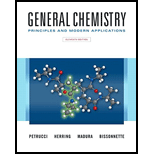
Concept explainers
(a)
Interpretation:
Equation for the substitution reaction of
Concept introduction:
Nucleophilic substitution reaction
Nucleophilic substitution reaction
The order of
Primary alkyl halide prefers to undergo
(b)
Interpretation:
Equation for the substitution reaction of
Concept introduction:
Nucleophilic substitution reaction
Nucleophilic substitution reaction
The order of alkyl halide reactivity towards
Primary alkyl halide prefers to undergo
(c)
Interpretation:
Equation for the substitution reaction of
Concept introduction:
Nucleophilic substitution reaction
Nucleophilic substitution reaction
The order of alkyl halide reactivity towards
Primary alkyl halide prefers to undergo
(d)
Interpretation:
Equation for the substitution reaction of
Concept introduction:
Nucleophilic substitution reaction
Nucleophilic substitution reaction
The order of alkyl halide reactivity towards
Primary alkyl halide prefers to undergo
(e)
Interpretation:
Equation for the substitution reaction of
Concept introduction:
Nucleophilic substitution reaction
Nucleophilic substitution reaction
The order of alkyl halide reactivity towards
Primary alkyl halide prefers to undergo
Want to see the full answer?
Check out a sample textbook solution
Chapter 27 Solutions
Generl Chem Looself&mod Mst/et&stdy Crd Pkg, 11/e
- Write a conformational structure for 1,2,3-trimethylcyclohexane in which all the methyl groups are axial and then show its more stable conformation.arrow_forward4. Write the formula and name for the product when cyclopentene reacts with (a) Cl2(b) HBr(c) H2, Pt (d) H2O, H+arrow_forwardFormaldehyde, H2C=O, is known to all biologists because of its usefulness as a tissue preservative. When pure, formaldehyde trimerizes to give trioxane, C3H6O3, which, surprisingly enough, has no carbonyl groups. Only one monobromo derivative (C3H5BrO3) of trioxane is possible. Propose a structure for trioxane.arrow_forward
- On a microscopic level, how does the reaction of bromine with an alkene differ from its reaction with an alkyne? How are they similar?arrow_forwardC7H9N has 4 degrees of unsaturation, what are the possible structures?arrow_forwardAn unknown hydrocarbon Q has a formula C6H12. Q Reacts with osmium tetroxide to give a diol R. When oxidized with KMnO4 in an acidic medium, Q gives two products. One product is propanoic acid and the other a ketone S. Provide reaction equations to identify the possible structures of Q, R and S.arrow_forward
- 2,2,3,3-Tetrabromopentane can be prepared by an addition reaction of excess Br2 with an alkyne. Draw the structure of the alkyne and name it.arrow_forward1,4-Pentadiene (CH2=CH-CH2-CH=CH2) is a liquid at room temperature and has a density of 0.66 g/mL and molar mass of 68.12 g/mol. In a laboratory experiment, 3.80 mL of this compound was treated with 4.80 mL of conc. H2SO4 (100% w/w; molar mass 98.08 g/mol). Note that the density of conc. H2SO4 is 1.84 g/mL. The resulting sulfate ester was then treated with 1.20 mL of water (molar mass 18.02 g/mol) affording, after work- up, 2,4-pentanediol (molar mass 104.15 g/mol) as the crude product. The crude product was then purified by simple distillation, which yielded 2.00 g of pure product. What is the theoretical yield of 2,4-pentanediol expressed in grams? Show calculations. What is the percentage yield of pure 2,4-pentanediol?arrow_forward1,4-Pentadiene (CH2=CH-CH2-CH=CH2) is a liquid at room temperature and has a density of 0.66 g/mL and molar mass of 68.12 g/mol. In a laboratory experiment, 3.80 mL of this compound was treated with 4.80 mL of conc. H2SO4 (100% w/w; molar mass 98.08 g/mol). Note that the density of conc. H2SO4 is 1.84 g/mL. The resulting sulfate ester was then treated with 1.20 mL of water (molar mass 18.02 g/mol) affording, after work- up, 2,4-pentanediol (molar mass 104.15 g/mol) as the crude product. The crude product was then purified by simple distillation, which yielded 2.00 g of pure product. a. Provide a balanced chemical equation to show the reaction between 1,4-pentadiene and sulfuric acid. Do not use molecular formulas in the chemical equation except for sulfuric acid. b. What reactant is the limiting reagent in this chemical equation? Show calculations to support your answer.arrow_forward
- A2 1. An alkyne with molecular formula C5H10 2. A ketone with molecular formula C4H8O 3. A ketone with molecular formula C3H8O 4. An alkene with molecular formula C5H8 5. An alkene with molecular formula C5H10 6. An aldehyde with molecular formula C2H4O 7. An aldehyde with molecular formula CH4O 8. A saturated hydrocarbon with molecular formula C6H14arrow_forwardAssign the hydrogens in C7H14O to this structurearrow_forwardwhich of the following statement/s is/are true about the reaction of 1-pentene with H2/Pt?arrow_forward
 Chemistry by OpenStax (2015-05-04)ChemistryISBN:9781938168390Author:Klaus Theopold, Richard H Langley, Paul Flowers, William R. Robinson, Mark BlaserPublisher:OpenStax
Chemistry by OpenStax (2015-05-04)ChemistryISBN:9781938168390Author:Klaus Theopold, Richard H Langley, Paul Flowers, William R. Robinson, Mark BlaserPublisher:OpenStax

